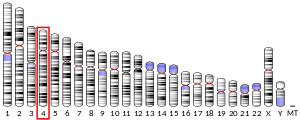CYP2U1
CYP2U1 (cytochrome P450, family 2, subfamily U, polypeptide 1) is a protein that in humans is encoded by the CYP2U1 gene[4]
Function
This gene encodes a member of the cytochrome P450 superfamily of enzymes. The cytochrome P450 proteins are monooxygenases which catalyze many reactions involved in drug metabolism and synthesis of cholesterol, steroids and the hydroxylation of fatty acids and fatty acid metabolites.[5] CYP2U1 metabolized arachidonic acid, docosahexaenoic acid (DHA), and other long chain fatty acids which suggests that CYP2U1 may play a role in brain and immune functions.[4] CYP2U1 also metabolizes propanone, acetone, and 2-oxypropane.
Tissue distribution
The CYP2U1 gene is a highly conserved gene that is mainly expressed in brain and thymus, but also at lower levels in kidney, lung, and heart.[6]
Reactions
CYP2U1 hydroxylates arachidonic acid, docosahexaenoic acid (DHA), and other long chain fatty acids at their terminal (i.e., ω) carbon to form 20-hydroxy-arachidonic acid (i.e. 20-Hydroxyeicosatetraenoic acid or 20-HETE), 22-hydroxy-docosahexaneoic acid, and other ω-hydroxy long chain fatty acids, respectively, plus lesser amounts of these fatty acids ω-1 hydroxy metabolites, i.e. 19-HETE, 21-hydroxy-docosahexaenoic acid, and other ω-1 hydroxy long chain fatty acids, respectively.[4] One of these metabolites, 20-HETE, is a regulator of blood pressure and blood flow to organs in animal models and, based on genetic studies, possibly in humans (see 20-Hydroxyeicosatetraenoic acid).
Clinical significance
A mutation (c.947A>T) in CYP2U1 has been associated in a very small number of patients with Hereditary spastic paraplegia in that it segregates with the disease at the homozygous state in two afflicted families. This mutation affects an amino acid (p.Asp316Val) that is highly conserved among CYP2U1 orthologs as well as other cytochrome P450 proteins; this p.Asp314Val mutation is located in the enzyme's functional domain, is predicted to be damaging to the enzyme's activity, and is associated with mitochondria dysfunction.[7][8] A second homozygous enzyme-disabling mutation has been identified in CYP2U1, c.1A>C/p.Met1?, that is associated with <1% of hereditary spastic paraplegia sufferers.[9] The reduction in 20-HETE production by these mutations, and thereby in 20-HETE's activation of the TRPV1 neural receptor, it is hypothesized, may contribute to the development of this disease (see 20-Hydroxyeicosatetraenoic acid for details).[7]
CYPU21 along with members of the CYP4A and CYP4F sub-families also ω-hydroxylate and thereby reduce the activity of various fatty acid metabolites of arachidonic acid including LTB4, 5-HETE, 5-oxo-eicosatetraenoic acid, 12-HETE, and several prostaglandins that are involved in regulating various inflammatory, vascular, and other responses in animals and humans.[10] This hydroxylation-induced inactivation may underlie the proposed roles of the cytochromes in dampening inflammatory responses and the reported associations of certain CYP4F2 and CYP4F3 single nucleotide variants with human Krohn's disease and Coeliac disease, respectively.[11][12][13]
References
- GRCh38: Ensembl release 89: ENSG00000155016 - Ensembl, May 2017
- "Human PubMed Reference:". National Center for Biotechnology Information, U.S. National Library of Medicine.
- "Mouse PubMed Reference:". National Center for Biotechnology Information, U.S. National Library of Medicine.
- Chuang SS, Helvig C, Taimi M, Ramshaw HA, Collop AH, Amad M, White JA, Petkovich M, Jones G, Korczak B (Feb 2004). "CYP2U1, a novel human thymus- and brain-specific cytochrome P450, catalyzes omega- and (omega-1)-hydroxylation of fatty acids". The Journal of Biological Chemistry. 279 (8): 6305–14. doi:10.1074/jbc.M311830200. PMID 14660610.
- "Entrez Gene: CYP2U1".
- Devos A, Lino Cardenas CL, Glowacki F, Engels A, Lo-Guidice JM, Chevalier D, Allorge D, Broly F, Cauffiez C (Aug 2010). "Genetic polymorphism of CYP2U1, a cytochrome P450 involved in fatty acids hydroxylation". Prostaglandins, Leukotrienes, and Essential Fatty Acids. 83 (2): 105–10. doi:10.1016/j.plefa.2010.06.005. PMID 20630735.
- Tesson C, Nawara M, Salih MA, Rossignol R, Zaki MS, Al Balwi M, et al. (Dec 2012). "Alteration of fatty-acid-metabolizing enzymes affects mitochondrial form and function in hereditary spastic paraplegia". American Journal of Human Genetics. 91 (6): 1051–64. doi:10.1016/j.ajhg.2012.11.001. PMC 3516610. PMID 23176821.
- Wortmann SB, Espeel M, Almeida L, Reimer A, Bosboom D, Roels F, de Brouwer AP, Wevers RA (Jan 2015). "Inborn errors of metabolism in the biosynthesis and remodelling of phospholipids". Journal of Inherited Metabolic Disease. 38 (1): 99–110. doi:10.1007/s10545-014-9759-7. PMID 25178427.
- Citterio A, Arnoldi A, Panzeri E, D'Angelo MG, Filosto M, Dilena R, Arrigoni F, Castelli M, Maghini C, Germiniasi C, Menni F, Martinuzzi A, Bresolin N, Bassi MT (2014). "Mutations in CYP2U1, DDHD2 and GBA2 genes are rare causes of complicated forms of hereditary spastic paraparesis" (PDF). J. Neurol. 261 (2): 373–81. doi:10.1007/s00415-013-7206-6. PMID 24337409.
- Hardwick JP (2008). "Cytochrome P450 omega hydroxylase (CYP4) function in fatty acid metabolism and metabolic diseases". Biochemical Pharmacology. 75: 2263–2275. doi:10.1016/j.bcp.2008.03.004.
- Eur J Hum Genet. 2006 Nov;14(11):1215-22
- Corcos L (2012). "Human cytochrome P450 4F3: structure, functions, and prospects". Drug Metabolism and Drug Interactions. 27. doi:10.1515/dmdi-2011-0037.
- Costea I (2014). "Interactions Between the Dietary Polyunsaturated Fatty Acid Ratio and Genetic Factors Determine Susceptibility to Pediatric Crohn's Disease". Gastroenterology. 146: 929–931.e3. doi:10.1053/j.gastro.2013.12.034.
External links
- Human CYP2U1 genome location and CYP2U1 gene details page in the UCSC Genome Browser.
Further reading
- Nelson DR (May 2004). "'Frankenstein genes', or the Mad Magazine version of the human pseudogenome". Human Genomics. 1 (4): 310–6. PMC 3525266. PMID 15588491.
- Wistow G, Bernstein SL, Ray S, Wyatt MK, Behal A, Touchman JW, Bouffard G, Smith D, Peterson K (Jun 2002). "Expressed sequence tag analysis of adult human iris for the NEIBank Project: steroid-response factors and similarities with retinal pigment epithelium". Molecular Vision. 8: 185–95. PMID 12107412.
- Nelson DR, Zeldin DC, Hoffman SM, Maltais LJ, Wain HM, Nebert DW (Jan 2004). "Comparison of cytochrome P450 (CYP) genes from the mouse and human genomes, including nomenclature recommendations for genes, pseudogenes and alternative-splice variants". Pharmacogenetics. 14 (1): 1–18. doi:10.1097/00008571-200401000-00001. PMID 15128046.
- Karlgren M, Backlund M, Johansson I, Oscarson M, Ingelman-Sundberg M (Mar 2004). "Characterization and tissue distribution of a novel human cytochrome P450-CYP2U1". Biochemical and Biophysical Research Communications. 315 (3): 679–85. doi:10.1016/j.bbrc.2004.01.110. PMID 14975754.
This article incorporates text from the United States National Library of Medicine, which is in the public domain.

